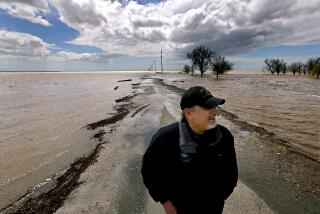Winter Makes a Dry Run Through Area
- Share via
Yes, it’s dry out. Drier than an average year. And you can’t blame La Nina anymore--that ended last fall.
But it’s not that bad, not like last winter, when the rain was so slight the hills never seemed to turn green. So tough it out. Rub a little moisturizer on your wind-chapped hands and revel in the envy of all those Rose Bowl-bound Purdue fans in from Indiana--where it was 15 degrees Thursday.
And be glad you’re not from Calgary, Canada, where it was 4 degrees.
“It’s like heaven here,” said Janette Martinson, a Calgarian who fled the snow and ice to spend the holidays with relatives in Burbank and Corona. “They make fun of us, that we’re going to freeze. It’s so cold there.”
“It’s gorgeous,” said her husband, Bill, stretched out on a towel on the sand near Newport Beach Pier. “I’ll stay here any time.”
Despite a 600-acre wildfire in Thousand Oaks this week and warm, gusty weather across the region, weather experts say this year’s mild winter so far falls within the normal range. They expect more winter rain to bring the seasonal rainfall total in line with average years.
But it doesn’t seem that way to firefighters. Los Angeles County firefighters kept a wary eye on intermittent Santa Ana winds, which can turn a spark into an inferno in seconds.
“When the humidity is low and winds are high, we call for a red flag, which alerts firefighters to be on standby with extra apparatus,” said Chris Casillas, a spokesman for the Los Angeles County Fire Department.
In Orange County, where the fire season is officially over, extra crews still are being deployed on fire calls in and near open areas as a precaution.
“We want to get out there and fight that fire fast and knock it down with lots of equipment because the dry weather could spread the flames real fast,” said Dennis Shell, spokesman for the Orange County Fire Authority. “Even though the fire season is closed, the fire hazard is still there in the wild land areas.”
The winter’s weather patterns were established early on by the dying remnants of La Nina, the cold-weather counterpart to El Nino, which brought deluges and mudslides to Southern California three years ago. Under La Nina conditions, Southern California usually dries out.
And that’s what happened last winter, when rainfall was a fraction of the usual 13 to 15 inches. For example, at one Santa Ana fire station, 3.61 inches of rain would have fallen by now in an average season, which begins July 1.
Last year, a minuscule 0.21 inches had fallen by this time. This year, 1.14 inches of rain have fallen, primarily because the beginning of the season overlapped with the end of La Nina.
“We expect the rain to return to normal,” said Lisa Wright, a meteorologist for the National Weather Service in San Diego. “We should get more rain in the coming months to make up for that deficit.”
But first, high-pressure systems have to stop building over the deserts to the east, said Chad Pettera, a meteorologist with WeatherData Inc., which provides weather information to The Times.
The high-pressure systems normally develop over the Great Basin of Utah and Nevada this time of year and act as atmospheric levees, diverting Pacific-spawned storm systems to the north and keeping Southern California dry. When those pressure systems dissipate or move eastward, the Pacific storms will track south.
And then the rains will fall, along with the temperatures.
The average high temperature for this time of year is 67 degrees. For the last couple of days, highs have reached the mid-70s, a swing that Pettera said was within normal ranges.
He said the week--and the year--will end dry. Normally, Southern California gets 14.47 inches of rain in a calendar year, an average that includes the wetter mountain regions and the drier valleys and canyons. So far, 11.93 inches of rain have fallen in 2000, he said.
Roy Herndon, a hydro geologist for the Orange County Water District, said the reduced rainfall so far has had no effect on the underground aquifer from which northern Orange County residents get about 75% of their water.
“It would probably have to be a prolonged drought of several years” to affect the aquifer, Herndon said.
Southern California’s wettest months typically are January through March, he said.
“We’re still just getting into the wet part of the year,” Herndon said.
In Newport Beach on Thursday, the only moisture in the air came from sea spray. The spring-like weather drew Jan Howell from her Mission Viejo home.
“It’s so nice. I love it,” Howell said, soaking up the midafternoon sunshine.
Howell had planned to spend the day skiing, thinking that visiting relatives from Pennsylvania might enjoy a few runs down a snow-covered slope in the mountains.
She thought wrong. The relatives went to Disneyland. Howell went to the beach.
“They said, ‘Don’t even take us to the cold. We came here to avoid the cold,’ ” Howell said.
Jake Devera of Irvine also made the most of the warm day, joining friend Brett Fitzgerald of Costa Mesa for a stroll along the beach with his friend’s dog in tow.
“It’s perfect to have spring weather in December,” Devera said. “That is why we live here.”
More to Read
Sign up for Essential California
The most important California stories and recommendations in your inbox every morning.
You may occasionally receive promotional content from the Los Angeles Times.













